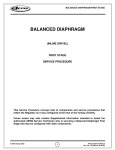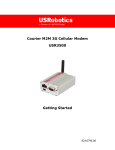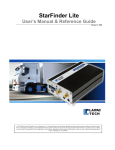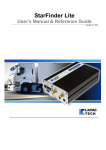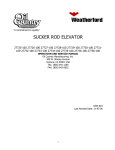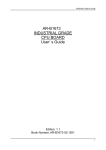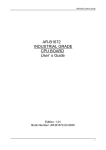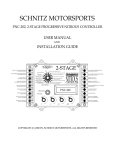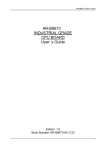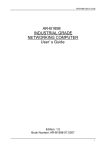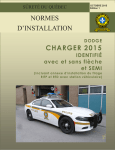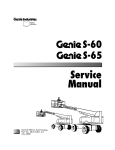Download Asset-Link 4XX User Manual
Transcript
Asset-Link 4XX User Manual Installation and Operating Instructions Revision: 1.1 Revision Date: June 17, 2004 Document Number: 970-00047 Specifications subject to change without notice Asset-Link 4XX User Manual 970-00047 May 10, 2004 Rev. 1.0 Record of Changes Version 1.0 1.1 1.2 CSI Wireless©2004 Date 11/24/03 06/17/04 07/19/04 Title or Brief Description Initial Release Revised No Audio Specifications subject to change without notice Entered By C. Carver L. Yu L. Yu Page ii Asset-Link 4XX User Manual 970-00047 May 10, 2004 Rev. 1.0 Acronyms and Abbreviations A AMPS BPS CCA Cellular DAC dB DC DPSK EIA ESD FCP FLASH GPS GPRS GSM I/O LCP mW PDI PPM RF rms RSSI RTC SAT SMB FAKRA ST TIA V CSI Wireless©2004 Amperes Advanced Mobile Asset-Link System Bits per Second Circuit Card Assembly A Asset-Link system based on cells of RF Digital to Analog Converter decibel Direct Current Differential Phase Shift Keying Electronics Industry Association Electrostatic Discharge Function Control Processor a non volatile memory type Global Positioning System General Packet Radio Service Global System Mobile Input or Output Local Controller Port – serial I/O milliwatt Packet Data Interface Parts per Million Radio Frequency Root Mean Squared or averaged Received Signal Strength Indicator Real Time Clock Supervisory Audio Tone RF Connector Based on FAKRA/USCAR Standards Signaling Tone Telecommunications Industry Association Volts Specifications subject to change without notice Page iii Asset-Link 4XX User Manual 970-00047 May 10, 2004 Rev. 1.0 Definitions Action Almanac Asset Power Baud Battery Power Ears-On Ears-Off Ephemeris Exception Fix Page Supply Power Typical 2-D 3-D CSI Wireless©2004 A programmed response to an exception. A subset of orbital parameters from the GPS satellite ephemeris used to calculate approximate satellite positions and velocities. External power provided by the host vehicle or asset. A unit of measurement specifying the signaling rate (Signals/Sec). Power provided by either the optional external 12-V backup battery or >7.0V internal battery. A system sub-state in Active operating mode that enables the cellular module (AMPS and MicroBurstTM Page). A system sub-state in Active operating mode when cellular module is switched off A set of GPS satellite parameters used to calculate precise satellite positions and velocities. A predefined event or condition that causes a programmed response (Action). A location determination The event of receiving a cellular telephone call via the AMPS Control Channel. Power provided to Asset-Link, regardless of source. Expected value under normal operating conditions. two dimensional three dimensional Specifications subject to change without notice Page iv Asset-Link 4XX User Manual 970-00047 May 10, 2004 Rev. 1.0 Table of Contents 1 INTRODUCTION.............................................................................................1-8 1.1 PURPOSE..........................................................................................................1-8 1.2 SCOPE ..............................................................................................................1-8 1.3 ASSET-LINK PRODUCT NUMBERING ................................................................1-8 1.4 REFERENCED DOCUMENTS ..............................................................................1-9 1.4.1 CSI-Wireless documents:...................................................................... 1-9 1.4.2 Public Documents or Standards ............................................................ 1-9 1.5 OPERATIONAL OVERVIEW .............................................................................1-10 1.6 SYSTEM PRODUCT FEATURES ........................................................................1-11 2 PRODUCT DESCRIPTION .............................................................................2-1 2.1 DETAILED SYSTEM DESCRIPTION ....................................................................2-1 2.2 MECHANICAL DIMENSIONS .............................................................................2-2 2.3 GPS RECEIVER ................................................................................................2-2 2.3.1 GPS Position/Velocity Fix .................................................................... 2-2 2.4 FUNCTION CONTROL PROCESSOR ....................................................................2-4 2.4.1 Non-Volatile Memory ........................................................................... 2-4 2.4.2 FCP Operating Modes........................................................................... 2-5 2.4.2.1 FCP Sleep Mode Operation.............................................................2-6 2.4.2.2 Active Mode ....................................................................................2-7 2.4.2.3 Full-Power Mode.............................................................................2-9 2.4.3 Power Off Mode.................................................................................. 2-10 2.4.4 Connection and Configuration ............................................................ 2-10 2.5 POWER MANAGEMENT ..................................................................................2-11 2.5.1 Power Input Protection........................................................................ 2-11 2.5.2 MicroBurst™, Control Channel Data ................................................. 2-11 3 APPLICATION I/O CONNECTOR SPECIFICATIONS ................................3-1 3.1 APPLICATION I/O CONNECTOR TYPE AND PINOUT ..........................................3-1 3.2 POWER INPUT SPECIFICATIONS ........................................................................3-2 3.2.1 Power Requirements ............................................................................. 3-2 3.2.2 Power Consumption Profile .................................................................. 3-2 3.2.3 Grounding “Precautions” ...................................................................... 3-2 3.2.4 Ground Wire Size.................................................................................. 3-3 3.2.5 Grounding Voltages .............................................................................. 3-3 3.2.6 Power Supply Over Voltage Protection ................................................ 3-3 3.2.7 Power Supply Reverse Voltage Protection ........................................... 3-3 3.2.8 Power Supply Decay to Zero Volts....................................................... 3-3 3.2.9 Power Supply Engine Start Disturbances ............................................. 3-4 3.2.10 Power Supply Connector ESD .............................................................. 3-4 3.2.11 Power Supply Connector Load Dump .................................................. 3-5 3.3 RELAY DRIVER SPECIFICATIONS .....................................................................3-6 3.4 ANALOG TO DIGITAL CONVERTER INPUTS ......................................................3-6 CSI Wireless©2004 Specifications subject to change without notice Page v Asset-Link 4XX User Manual 970-00047 May 10, 2004 Rev. 1.0 3.5 PIC SERIAL DATA OUTPUT ............................................................................. 3-6 3.6 PIC SERIAL DATA INPUT ................................................................................ 3-6 4 AMPS/GSM CONNECTOR SPECIFICATIONS............................................ 4-1 4.1.1 4.1.2 4.1.3 4.1.4 4.1.5 4.1.6 5 GPS CONNECTOR SPECIFICATIONS ......................................................... 5-1 5.1.1 5.1.2 5.1.3 5.1.4 5.1.5 5.1.6 6 AMPs/GSM Cellular Interface Specification ........................................4-1 Cellular Connector Shield......................................................................4-2 Cellular Center Pin Voltage Protection .................................................4-2 Cellular Center Pin Short To Ground or Open Protection.....................4-2 Cellular Center Pin Over Current Protection.........................................4-2 Cellular Center Pin ESD Protection ......................................................4-2 GPS Connector ......................................................................................5-1 GPS Connector Shield ...........................................................................5-1 GPS Connector Center Pin Voltage Protection .....................................5-1 GPS Connector Center Pin Short To Ground or Open Protection.........5-1 GPS Connector Center Pin Over Current Protection.............................5-2 GPS Connector Center Pin ESD Protection ..........................................5-2 ANTENNAS ..................................................................................................... 6-1 6.1 CELLULAR AND GSM ANTENNA ..................................................................... 6-1 6.2 GPS ANTENNA ............................................................................................... 6-2 7 ENVIRONMENTAL SPECIFICATIONS ...........................................................3 7.1 ENVIRONMENTAL SPECIFICATIONS .....................................................................3 7.2 VIBRATION AND DROP TEST REQUIREMENTS .....................................................4 7.2.1 Vibration ................................................................................................... 4 7.2.2 Drop Test .................................................................................................. 4 7.3 EMC REQUIREMENTS .........................................................................................5 7.3.1 Regulatory EMC Requirements................................................................ 5 7.3.2 EMC with vehicle broadcast receivers ..................................................... 6 8 INSTALLING ASSET-LINK IN A VEHICLE ...................................................7 8.1 ANTENNA POSITIONING ......................................................................................7 8.2 MOUNTING LOCATION ........................................................................................9 8.3 I/O CONNECTION AND HARNESS DESIGN..........................................................10 CSI Wireless©2004 Specifications subject to change without notice Page vi Asset-Link 4XX User Manual 970-00047 May 10, 2004 Rev. 1.0 List of Figures Figure 1 Typical Asset-Link Unit Deployment...................................................... 1-10 Figure 2 Asset-Link Functional Block Diagram ..................................................... 2-1 Figure 3 - Operating Mode Transitions .................................................................... 2-9 Figure 6 Vehicle Battery Voltage Drops During Engine Start................................. 3-4 Figure 7 Load Dump Pulse Test............................................................................... 3-5 Figure 8 Vibration Specifications.................................................................................4 List of Tables Table 2-1 GPS Receiver Characteristics .................................................................. 2-2 Table 2-2 Establishment of Position Fix .................................................................. 2-3 Table 4-1 DB-25 Application I/O Connector Pin-Out ............................................. 3-2 Table 4-2 Asset Power - Absolute Maximum Ratings............................................. 3-2 Table 4-3 Asset Power Characteristics..................................................................... 3-2 Table 4-4 Power Consumption................................................................................. 3-2 Table 4-5 Load Dump Pulse Characteristics ............................................................ 3-5 Table 4-12 Microphone Input Characteristics..................................not included Table 4-13 Earpiece Output Characteristics...........................................not included Table 6-1 Cellular Interface Characteristics............................................................. 4-1 Table 7-1 GPS Connector Characteristics................................................................ 5-1 Table 8-1 GSM & Cellular Antenna ........................................................................ 6-1 Table 8-2 GPS Antenna............................................................................................ 6-2 Table 10-1 Environmental Specifications ....................................................................3 Table 10-2 Temperature Specifications .......................................................................3 CSI Wireless©2004 Specifications subject to change without notice Page vii Asset-Link 4XX User Manual 970-00047 May 10, 2004 Rev. 1.0 1 Introduction 1.1 Purpose This document describes the basic user guide for the operation of the ASSET-LINK™ family of products. 1.2 Scope This manual describes the relevant hardware and firmware features in the necessary detail for Telematics system developers. The primary interface with the product firmware is based on a proprietary CSI Wireless communications interface called PDI (Packet Data Interface). The Asset-Link allows communication on GSM and Cellular networks for maximum coverage in the Americas. The product includes Aeris MicroBurstTM to allow small packet information transfer over the Cellular Networks. The Asset-Link also has an integral GPS receiver that allows position-sensing information to be available both locally, over packet networks, by SMS and by the public switched wireless networks. Detailed information on communications with the Asset-Link using PDI (Packet Data Interface) or Application Development for the Asset-Link requires the use of AVL 2004 User Manual (97000050). 1.3 Asset-Link Product Numbering The Asset-Link product numbering is composed of a 4 digit number followed by a 2 digit firmware/ accessory suffix (4XYZ-AB). The first digit is always 4 for GSM products, the next five digits decode as follows: Digit 2 Digit 3 Digit 4 Frequency Bands (Cellular/DCS/PCS/etc.), “0” used for AMPS only. Data or Modulation Type (MicroBurst, GPRS, etc.), “0” if none. GSM data capability – “0” if not GPRS capable Digit 5 Digit 6 FCP firmware level Accessories included CSI Wireless©2004 Specifications subject to change without notice Page 1-8 Asset-Link 4XX User Manual 970-00047 1.4 May 10, 2004 Rev. 1.0 Referenced Documents 1.4.1 CSI-Wireless documents: 970-00050 AVL 2004 User Manual (Asset-Link 4XX Series) 910-00044 PDI Interface Manual, Asset-Link and AssetVision 1.4.2 Public Documents or Standards GPS ICD-200C-004 NAVSTAR GPS Navigation User Interface Definition (12 April 2000) TIA/EIA/IS-91 Mobile Station – Base Station Compatibility Standard for 800 MHz Analog Cellular. October 1994. TIA/EIA-690 Recommended Minimum Standards for 800 MHz Cellular Subscriber Units, November 1, 2000 EIA/TIA-553 Mobile Station – Land Station Compatibility Specification. September 1989. CSI Wireless©2004 Specifications subject to change without notice Page 1-9 Asset-Link 4XX User Manual 970-00047 1.5 May 10, 2004 Rev. 1.0 Operational Overview The Asset-Link series of products, extends the product family from CSI Wireless with addition of GSM to the original Asset-Link 200 product. The Asset-Link provides a comprehensive range of features for vehicle management, remote diagnostics, control and positioning at an affordable price. The Asset-Link integrates GSM and Cellular (AMPS) data communications, global positioning (GPS) and an intelligent power management system to permit asset tracking, event monitoring, action scheduling, and vehicle parameter control. The product uses a proprietary parameter driven configurable architecture to permit optimization for individual applications. Figure illustrates a typical Asset-Link ™ unit deployment. Figure 1 Typical Asset-Link Unit Deployment CSI Wireless©2004 Specifications subject to change without notice Page 1-10 Asset-Link 4XX User Manual 970-00047 1.6 May 10, 2004 Rev. 1.0 System Product Features The Asset-Link product has the following major features • Power management system for controlling power consumption on wide variety of vehicles and equipment with 12 volt or 24 volt electrical systems. • GPS position determination, with more than 60 days of position storage in memory. • Integrated AMPS Class 3 Cellular Radio. • AMPS control channel MicroBurst™ data ability • AMPS or GSM circuit switched data • GSM 2 watt (EGSM/GSM850) – 1watt (GSM1800/PCS1900) module • GSM SMS messaging using Text • Class 10 GPRS packet data capability with embedded TCP/IP capability • Configurable application with 50 Geo–fences, 64 exceptions, 64 meters of 4 varieties (interval, event, odometer and elapsed), 64 action groups (with up to 8 actions each) and 40 configurable schedules (with 21 discrete times or 7 periodic schedules each with local or GMT time settings) • 16 I/O ports (2 relay drivers, 8 GPIOs and 4 analog inputs, plus 2 serial ports). • Eight digital bi-directional ports, 3 of 8 with wake-up capability • Four 10 bit analog inputs for measuring temperature and other sensor inputs • Two serial communications ports – one of these ports can be ordered as a dedicated RS232 port for data communications needs, USB available soon. • Two relay drivers that sink up to power to ground for conventional automotive relays • I2C or SPI ports are available (shared with digital ports 4, 7 & 8) • Real-time clock for scheduling and power management. CSI Wireless©2004 Specifications subject to change without notice Page 1-11 Asset-Link 4XX User Manual 970-00047 May 10, 2004 Rev. 1.0 2 Product Description nvSRAM Flash RS232 Txvr GPS Rx FCP (ARM7) Serial Tx/Rx D B 2 5 Audio 5V reference CAN Bus 4 ADC 8 GPIO (SPI) 1 UART 2 Relay Drivers Asset Pwr PIC I/O uController GSM Radio Modem D B 9 8-36V Power Supply AMPS Radio Figure 2 Asset-Link Functional Block Diagram 2.1 Detailed System Description The following sections provide a description of the various system components. Figure 2 on the preceding page is a block diagram of the Asset-Link system depicting the major system components and interfaces. CSI Wireless©2004 Specifications subject to change without notice Page 2-1 Asset-Link 4XX User Manual 970-00047 2.2 May 10, 2004 Rev. 1.0 Mechanical Dimensions The Asset-Link enclosure for the product will be approximately 5.8” x 3.4” x .9” to the outside of the connectors. 2.3 GPS Receiver The Asset-Link incorporates a low power integrated twelve-channel GPS receiver. The GPS receiver is designed by CSI-Wireless utilizing the SiRFstarII LP GPS architecture, which includes acquisition accelerator and multi path mitigation hardware. The GPS receiver complies with ICD-GPS-200C. The Asset-Link Global Positioning System (GPS) receiver shares the ARM7 processor with the FCP to determine position and provide control functions. The time to position determination and the accuracy of position determination are dependant upon the GPS LNA antenna performance as well as the GPS Antenna. The frequencies used for the GPS receiver are centered on 1574 MHz, which are referred to as L1. Other GPS frequencies are not supported by the Asset-Link . The Asset-Link does not support WAAS. Parameter GPS Receive Frequencies Tracking capabilities Solution Update Rate Satellite Reacquisition “Snap” Start time “Warm” Start time “Cold” Start time Signal Level Maximum position speed Position accuracy SA off Position accuracy SA on Velocity determination Min 1569 4 -45 8 26 40 -155 0 ---- Nominal 1574 7 -80 8 35 45 -141 -10 100 1 Max 1579 12 1 100 20 38 120 -108 999 14 120 -- Units MHz Satellites seconds milliseconds Seconds Seconds Seconds DBm knots meters 2D rms meters 2D rms meter/sec Table 2-1 GPS Receiver Characteristics 2.3.1 GPS Position/Velocity Fix The GPS receiver establishes a position fix with a 95% certainty as shown in Table 2-2. The following data provided by SiRF assumes a full view of the sky (360° azimuth), actual field data will vary with antenna installation. If the satellites are not equally distributed around the horizon as often happens in urban canyons, and in covert vehicle installations, the fix circular error is more like a large oval. The result is a large “DOP” (dilution of precision) and a lower fix accuracy, as well as an increased time to first fix. Increased DOP (HDOP –horizontal CSI Wireless©2004 Specifications subject to change without notice Page 2-2 Asset-Link 4XX User Manual 970-00047 May 10, 2004 Rev. 1.0 error, VDOP – vertical error and TDOP – time error) affects fix accuracy but not fix update rate, only time to first fix (TTFF). Cold Start TTFF < 45 seconds (avg.) Warm Start < 38 seconds (avg.) Hot Start < 8 seconds (avg.) SiRF Definition A condition in which the GPS can arrive at a navigation solution without initial position, time, current ephemeris, and almanac data. Start mode of the GPS receiver when current position, clock offset and approximate GPS time are input by the user. Almanac is retained, but ephemeris data is cleared. Start mode of the GPS receiver when current position, clock offset, approximate GPS time and current ephemeris data are all available. Table 2-2 Establishment of Position Fix Upon initial startup the GPS almanac data is downloaded from the GPS satellites and requires 12.5 minutes to download completely. The almanac is updated weekly and is typically valid for up to a month. On subsequent startups the almanac data does not have to be reloaded provided it is still valid. To achieve a hot start the receiver must have current satellite ephemeris data (each satellite transmits its own orbital parameters). The satellite ephemeris data is transmitted every 30 seconds, changes every hour, and is valid for up to 4 hours. In Asset-Link the satellite elevation threshold is set to 7.5 degrees above horizon, this cannot be changed by configuration. Stored GPS position information will be updated when the Asset-Link GPS is powered ON and receiving enough satellite information to calculate position and velocity information (nominally 4 satellites). An internal filter screens out low PDOP (position dilution of precision) fixes. The GPS receiver is powered on in the Full Power mode and can be independently powered on or off in the Active mode. A GPS “warm up delay” uses a configurable timer to delay certain actions requiring a GPS fix, such as a cellular “check-in”, until the GPS has an opportunity to get a fix (nominally set to 45 seconds). When GPS receiver is on, it acquires GPS fix once a second. GPS information can be requested through PDI commands, information such as: • Date/Time the request for position information was processed. • GPS position (latitude, longitude, and altitude). • GPS time of week and week number indicating when this fix information was calculated (time of fix). • GPS 3-D velocity vectors (east, north, and up velocity vectors) or plane speed and direction. • Fix type, providing status of the fix (available/not available,number of satellite vehicles used for fix, etc). CSI Wireless©2004 Specifications subject to change without notice Page 2-3 Asset-Link 4XX User Manual 970-00047 • • May 10, 2004 Rev. 1.0 GPS receiver status (antenna feed line fault, not detected, number of satellite vehicles tracking) GPS tracking for each satellite vehicle (azimuth, elevation, average carrier/noise, ephemeris available, code locked, carrier pull-in, acquisition failed, bit synchronization, sub-frame synchronization). In both the Active and Full-Power mode, the GPS position is continuously logged to non-volatile memory along with other Asset-Link status parameters. This information is logged every second to nvSRAM, and saved to Flash when the system is powered down. Please refer to section Error! Reference source not found. for GPS configurable parameters 2.4 Function Control Processor The FCP module in the ARM processor of the GPS receiver is the central intelligence of the Asset-Link unit. The FCP module manages the cellular and GSM module connection and controls the application. The application is controlled by the navigation solution and performs exception handling (such as input signal and Geofence exceptions) based on schedules and actions. 2.4.1 Non-Volatile Memory Cellular Module SRAM 16 Kbit Cellular Module FLASH 512 Kbit FCP nvSRAM 512 Kbit FCP FLASH 32 Mbit The FCP code consumes less than 20% of the available code space and allows sufficient room for the complete download of new image in the case of an OTAP. About 256K of space is reserved for constrain regions and geopolitical boundaries. The balance of the flash memory (about 16M) is used for message and record storage. The Asset-Link FCP uses two types of non-volatile memory storage: parallel nvSRAM memory, and FLASH memory. Memory Type ARM nvSRAM ARM FLASH Life Expectancy Infinite Write Cycles to SRAM 1M Store Cycles to nonvolatile elements 1M Erase & Program Cycles The Cellular and GSM transceivers have separate Serial SRAM memory, and FLASH memory. Memory Type Serial SRAM FLASH CSI Wireless©2004 Life Expectancy 1M Write Cycles 10k Cycles Specifications subject to change without notice Page 2-4 Asset-Link 4XX User Manual 970-00047 May 10, 2004 Rev. 1.0 2.4.2 FCP Operating Modes The following description of the four operating modes and power management is a very general description of the Asset-Link programming. Application providers can and should develop their own specific configuration to maximize connectivity and minimize battery consumption. Developers can use meters, voltage thresholds, I/Os, actions, exceptions and schedules to create unique applications by the PDI commands available through the AVL 2004 program. There are four major states for the FCP: 1. No Power 2. Sleep 3. Active 4. Full Power Each may be invoked in response to exceptions that are logically combined with either I/O inputs and/or voltage level of power resources. To create such a configuration, the reader should refer to the AVL 2004 User Manual (970-00050). Each of these states has specific power consumption and abilities, which are detailed in the later sections of this manual. Figure 3 shows the various power modes and operational states. Switching between modes (or states) can be determined by singular, or combination events. (It must be noted that some of these events can act in concert, in an additive manner, while others are normally set to act alone, and still others are dominant over another). The I/O controller monitors a majority of the bus activity (including serial and analog inputs) using an I/O timer. The I/O timer is set following the detection of an activity at the I/O ports. The I/O timer can also be set by a configurable action group. Both of these monitoring events maximizes the potential for the FCP to remain in the sleep mode and thus conserve power. The following are routinely monitored by the FCP: • Activity on I/O controller or the FCP serial port • Changing of the voltage of the power supply as measured at the main input of the device, to a configurable threshold • Expiration of the GPS warm-up timer, GPS fix Duration timer and Ears-On timer. Ears-On timer is set when the cellular module is turned ON by a configurable action group of an exception. The GPS timers are configurable GPS parameters and are set when turning ON GPS receiver. • Schedule keeping • Active Elapsed timers that run over the threshold • Exceptions that call Full-Power action The following parameters relating to mode transition are configurable in the hardware. AVL-2004 (see AVL 2004 User Manual 970-00050), the configuration development tool, provides the usable value for each setting: V SUPPLY Hi to Lo and Lo to Hi threshold CSI Wireless©2004 Configurable 0 to 26 Volts Specifications subject to change without notice Page 2-5 Asset-Link 4XX User Manual 970-00047 May 10, 2004 Rev. 1.0 VAnalog1-4 Hi to Lo and Lo to Hi threshold Configurable 0 to 26 Volts I/O timer Configurable between 2 s to 65535 s Ears-On Timer Configurable between 2 s to 65535 s GPS warm-up timer Configurable between 0 to 255s GPS fix duration timer Configurable between 0 to 65535s I/O inputs poll rate (Power off mode) Configurable 2 to 63 s Note: nominal supply voltage range should be 8-36V DC. 2.4.2.1 FCP Sleep Mode Operation In the Sleep Mode, the only section doing any processing is the Real Time Clock (RTC). The processor periodically enters the “Activity Check” state from the Sleep Mode. The interval for entry to the Activity Check state is configurable from 2 to 63 seconds and it is recommended 10-30s is used. In this mode the total power consumption is nominally about 35uA. In addition to the RTC, the I/O controller hardware is able to detect changes (interrupts) on the serial port on the 25 pin connector (pin 9), three of the eight digital GPIOs (GPIO 1, 2 & 3 – pins 2,15 & 3, respectively) and on the supply. The AssetLink can be made to enter “Activity Check” sub-mode with activity on these lines. When doing the Activity Check, the four analog inputs, the power supply voltage; and the Schedules and Elapsed timers are also checked. If any of these activities have events that require processing, the Asset-Link will transition to Active mode. When the Asset-Link enters Active mode, the two GPS timers, the ears-on timer and the I/O timer are set, according to the configuration and the trigger, and begin to count down to the time when Sleep mode will be entered. Under most configurations when using SMS for data communications, it is advisable that the device be configured to issue a status message before entry into the PowerOff mode. The status message will alert the host that the client device has entered the Power-Off mode and thus can no longer respond. Many applications do the same for entry into the Sleep mode, this alerts the service provider that the device can no longer receive messages. In a usual vehicle application, the device shall remain in the Sleep mode until awakened by either detecting the vehicle’s switched ignition circuit turned on via one of the analog input, or upon sensing appropriate “wake-up” activity on one of the three ‘wake’ digital GPIOs. The following functions are disabled while the FCP is in the Sleep mode: • GPS Receiver • Cellular and GSM module • Data Log and Batch Processor • Timer (except elapsed timer) and Exception Handler • Action Processor CSI Wireless©2004 Specifications subject to change without notice Page 2-6 Asset-Link 4XX User Manual 970-00047 May 10, 2004 Rev. 1.0 Note: GPS receiver can be set to always ON when in Active mode. In this case the two GPS timer will not take effect in the transition from Active mode to Sleep mode, i.e., once the Ears-On timer and I/O timer expire, Asset-Link will transition to Sleep mode. 2.4.2.2 Active Mode Active Mode, a mode in which digital and analog inputs are monitored continuously; additionally, one of the radio modules and GPS receiver are on or off (Ears-On and Ears-Off, GPS On and GPS Off) at times according to actions configured. Note: only one radio (AMPS or GSM) can be “Ears-On” at a time). Upon entering this mode from Sleep, the GPS receiver will be turned on and the two GPS timers – (1) warm-up timer and (2) “max fix” timer, are set according to GPS parameters configuration. When entering the Active mode from sleep, based on different triggering activities, the I/O timer and Ears-On timer are set to count down with different values: • Triggered by digital input: I/O = 30s • Triggered by analog input: I/O = 300s • Triggered by serial port: Ears-On=300s, I/O=300s • Triggered by schedule or Elapsed timer: I/O = 60s + Sleep wake-up interval • Triggered by power supply: Ears-On = 300s, I/O =300s An action can be invoked by an exception during the Active mode to reset the I/O timer to any value up to 65535 seconds in order to prolong the mode. If the either LCP port is active, the timer will continuously be set to 5 seconds in order to let the LCP communication complete. The Cellular or GSM Ears-On timer can also be set to any value up to 65535 seconds through an action or a schedule. Once the Ears-On timer expires, the appropriate radio module will be switched off and the Asset-Link will again return to the “EarsOff” sub-mode. The capability to turn the GPS receiver ON/OFF is also configurable. If the GPS power control capability is disabled (GPS receiver not allowed to power OFF), then the GPS receiver is always ON when Asset-Link is in the Active mode. If the max fix interval capability is enabled, then the GPS receiver is turned ON for a period of time defined by “warm-up delay timer” and “GPS fix max duration timer” when entering Active mode. Depending on the settings, when both the two timers countdown to zero or a GPS fix is obtained, GPS receiver will be shut off. The GPS receiver can also be shut off any time by an action. If all the timers -- the two GPS timers, Ears-On and I/O timers, expire in Active mode, the Asset-Link will transition to Sleep mode. If the GPS receiver is set to be always ON in Active mode, then only the Ears-On and I/O timers expiration will lead Asset-Link to transition back to the Sleep mode. CSI Wireless©2004 Specifications subject to change without notice Page 2-7 Asset-Link 4XX User Manual 970-00047 May 10, 2004 Rev. 1.0 The Active Mode allows the Asset-Link to operate at different power levels based on configurations that are programmed for specific operating requirements. In most configurations, the Asset-Link will enter this mode from “Full-Power” immediately upon detecting the vehicle’s switched ignition circuit going to OFF (normally applied to one of the digital inputs). In most cases the Asset-Link is configured to prevent the device from remaining ON for a protracted period of time and depleting the asset power (battery) after the ignition is turned OFF. This can be achieved by a proper configuration of timers, VSUPPLY threshold, action groups etc. If vehicle battery voltage is used for mode transition, be aware that the voltage can drop below 11.0v during vehicle start. The voltage will normally rise above 13.8v immediately after engine starts. Voltage transients of ±3.5v are not unusual on diesel engines during engine start. In some applications, issuing an alerting message to the application when entering Active mode from “Sleep” is recommended so that the host is notified that the client device is able to receive messages. While in the Active mode, the device shall continue to support all routines and activities supported in the Full Power mode: • GPS (fix updates, constraint regions, constraint groups) • Cellular and GSM modules (listening for any pages, packet data, calls or SMS messages from the host when Ears-On) • Check power supply voltage • Check digital, analog and LCP inputs. • Data Log and Batch Processor • Timer, Event Monitor and Exception Handler • Action Scheduler • Action Processor CSI Wireless©2004 Specifications subject to change without notice Page 2-8 Asset-Link 4XX User Manual 970-00047 May 10, 2004 Rev. 1.0 Sleep 2-63sec timeout OR Activity on LCP Port OR Activity on any of 3 Interruptible GPIOs OR Power Interruption Activity Check Sleep No Activity Activity on LCP Port OR Activity on any of 3 Interruptible GPIOs OR Power Interruption OR VANALOG1,2,3 or 4 >/< Threshold1,2,3 or 4 OR Active Schedule OR Active Over-threshold OR Elapsed Timer Ears_ON Timer Off AND I/O Timer Off AND GPS Warm-up Timer Off AND GPS Fix Duration Timer Off Active Ears_ON Timer ON Ears_Off Ears_On LCP Active OR set I/O Timer=20sec. Ears_ON Timer Off GPS Timer ON GPS_Off GPS_On GPS Timer Off Full_Powe r Flag True Full_Powe r Flag False Full Power Figure 3 - Operating Mode Transitions The above figure shows the relationship of the three primary operational modes and how Asset-Link transitions from one mode to another. 2.4.2.3 Full-Power Mode This is the full operational mode for the FCP. In this mode either the AMPS Cellular Radio or the GSM module and the GPS receiver are powered on continuously. The Asset-Link continuously monitors analog and digital I/O inputs, the power supply voltage levels, and exceptions that have been enabled. The Asset-Link continuously receives GPS position fixes and the AMPS Cellular Radio or GSM module is in a standby mode waiting for a page. If the communication via the AMPS Cellular Radio or GSM module is necessary, the FCP will communicate the appropriate information via the appropriate radio. When in Active mode, “Full-Power enabled” action can cause Asset-Link transition to the Full-Power mode. While in Full-Power mode the device shall support all routines and activities, as follows: CSI Wireless©2004 Specifications subject to change without notice Page 2-9 Asset-Link 4XX User Manual 970-00047 • • • • • • • • May 10, 2004 Rev. 1.0 GPS (fix updates, constraint regions, constraint groups) Cellular module (Standby for CSD connection or MicroBurst® messages transmission and receiving) Check power supply voltage Check digital, analog and LCP inputs. Data Log and Batch Processor Event Monitor and Exception Handler Action Scheduler Action Processor Section Error! Reference source not found. describes how to configure an exception with the “Full-Power” action. A typical exception configuration might be to use a Boolean combination of: • One digital input connected to engine ignition (key on indicator) • One analog input connected to oil pressure (engine running indicator) 2.4.3 Power Off Mode The Power-Off mode is the lowest power consumption mode. Under most configurations when using Microburst for data communications, it is advisable that the device be configured to issue a Reverse Control Channel (RECC) status message before entry into the Power-Off mode. The status message will alert the host that the client device has entered the Power-Off mode and thus can no longer receive Forward Control Channel (FOCC) messages. In a usual vehicle application, the device shall remain in the Power-Off mode until awakened by either detecting the vehicle’s switched ignition circuit turned on via one of the analog or digital input, or upon sensing other appropriate “wake-up” activity. For GSM operations the SMS messages will be stored for the configured period of time (normally 24 hours). 2.4.4 Connection and Configuration One challenge remains for the application provider/developer of the Asset-Link configuration. That is while fulfilling all the necessary application features, reducing the consumption of asset power (vehicle battery) and backup battery (when installed) to yet allow the Asset-Link to run and connect to the network for as long as possible. This can be achieved by a careful design of the transition conditions of operating modes, which could include I/O inputs, exceptions, schedules etc. For a detail description of I/O connection and configuration of exceptions and etc., please refer to Chapter Error! Reference source not found. and to the Asset-Link 4XX User Manual. Many helpful hints are provided in the User Manual. CSI Wireless©2004 Specifications subject to change without notice Page 2-10 Asset-Link 4XX User Manual 970-00047 2.5 May 10, 2004 Rev. 1.0 Power Management The Power management provides for the powering of all components within the Asset-Link from the VIN_POS and VIN_NEG pins on the DB-25 connector. The supply design is for a 12-volt or 24-volt vehicular system, and this includes: • The conditioning of an external +8 to +36 volt power supply source. • Over-current protection on the supply inputs. • Over-voltage and under-voltage protection on the supply inputs. • Reverse voltage application protection • Internal +5, 4.2, 3.6, 3.3 and 1.8 volt regulation. • Power supply voltage sensing to support mode transitions. • A low current draw in Sleep mode to maintain vehicle batteries. 2.5.1 Power Input Protection The power inputs are protected with a combination of self-resetting fuse and transient voltage suppressor (TVS). The self-resetting fuse protects the circuit in the event of an over current fault caused by reversed voltage or over voltage application, and allows power re-application when the fault is removed. Refer to the Power Supply Input section for further details. External 2 ampere slow-blow fuses, located in series with the +VIN and one of the two –VIN lines, are recommended to protect the vehicle and the wiring, and comply with safety standards. The device is protected internally. 2.5.2 MicroBurst™, Control Channel Data Asset-Link supports MicroBurstTM, a “control-channel” technology that provides simple, reliable, efficient, and economic alternative for wireless data communications. By using the control channels (FOCC and RECC) in the AMPS bandwidth, a user can send and receive data. The FOCC uses multiple MINs and the RECC uses a unique dial number that represents data. The use of the control channels for data transmission limits the amount of data that can be transported. A SID table is used for the MicroBurst™ application. The SID table is dynamically updated and maintained by Aeris Corporation. The Asset-Link meets the Aeris requirements for MicroBurstTM service certification on the initial shipment date. In this mode the cellular module will only recognized the MicroBurst™ MINs and will not recognize the circuit switched data’s NAM settings. The nature of the Asset-Link radio design is such that it will achieve 99.5% or better reception of MicroBurstTM messages under controlled conditions and approximately 96% of messages under real world conditions. Please refer to section Error! Reference source not found. for configuration parameters used to establish a Microburst™ connection. CSI Wireless©2004 Specifications subject to change without notice Page 2-11 Asset-Link 4XX User Manual 970-00047 May 10, 2004 Rev. 1.0 The following is a preliminary tutorial of MicroBurst™. For more detail information, please visit the MicroBurst™ developer’s net. The MicroBurst™ network is made up of five basic component groups: • Cellular air link and carrier, which provides wireless connectivity from the Aeris.net™ hub facility out to the MicroBurst™ endpoint devices • Signaling System 7 (SS7) network, which authenticates devices and transports IS-41 signals – including the MicroBurst™ data packets – between Aeris.net’s central hub facility and the cellular carrier switches. • Internet and dedicated TCP/IP data links provide transport for the data traffic between the Aeris.net hub and application host facilities, from which the endpoint devices are remotely monitored and controlled • Aeris.net central hub facility, which provides the central processing functions for the MicroBurst™ service • MicroBurst™ devices, which are application-specific, programmable telemetry units that consist of a cellular transceiver (referred to as the MicroBurst™ RF Module); a micro-controller with memory; MicroBurstspecific firmware; a CMOS serial connection between the Module and microcontroller; and sensors, as appropriate MicroBurst™ service uses standard cellular control channels to transmit and receive data to and from MicroBurst™ devices. There are two types of control channels: Forward Control Channels (FOCC), which operate from the cellular switch out to the MicroBurst™ device, and the Reverse Control Channels (RECC), which operate from the MicroBurst™ device back to the switch. CSI Wireless©2004 Specifications subject to change without notice Page 2-12 Asset-Link 4XX User Manual 970-00047 3 May 10, 2004 Rev. 1.0 Application I/O Connector Specifications The Asset-Link makes use of a DB-25 connector that is accessible by the user on the outside of the chassis for general-purpose I/O features. 3.1 Application I/O Connector Type and Pinout The DB-25 application I/O connector can be either a compact right angle (Kycon type K31-B25S-NJ or equivalent) or vertical style (Kycon type K85-BD-25S) depending on the manufacturing SKU. The DB-25 connector pin allocation is: DB-25 Pin I/O Pin 1 Pin 2 Pin 3 Pin 4 Pin 5 Pin 6 Pin 7 Pin 8 Pin 9 Pin 10 Pin 11 Pin 12 Pin 13 Pin 14 Pin 15 Pin 16 Pin 17 Pin 18 Pin 19 Pin 20 Pin 21 Pin 22 Pin 23 Pin 24 Pin 25 CSI Wireless©2004 Connection CAN BUS High (Future feature) Digital GPIO 1 Digital GPIO 3 Digital GPIO 5 SPI BUS - SDI I2C BUS – SDA Digital GPIO 7 SPI BUS – SDO ADC 1 ADC 3 Relay Driver 1 PIC Serial Data In 5V_EXT Audio In (Future feature) VIN_NEG VIN_POS CAN BUS Low (Future feature) Digital GPIO 2 Digital GPIO 4 Digital GPIO 6 Digital GPIO 8 SPI BUS - SCL I2C BUS - SCK ADC 2 ADC 4 Relay Driver 2 PIC Serial Data Out Audio Out (Future feature) VIN_NEG VIN_POS Activity Monitor N/A Yes (Interrupt) Yes (Interrupt) No No Yes (Polled) Yes (Polled) No Yes (Interrupt) N/A No No Yes (Polled) N/A Yes (Interrupt) No No No Yes (Polled) Yes (Polled) No No No No Yes (Polled) Specifications subject to change without notice Page 3-1 Asset-Link 4XX User Manual 970-00047 May 10, 2004 Rev. 1.0 Table 3-1 DB-25 Application I/O Connector Pin-Out 3.2 Power Input Specifications 3.2.1 Power Requirements The Asset-Link unit operates from either a 12V or 24V DC electrical system over a permissible range as shown in Table 3-2 and Table 3-3. Parameter Input Voltage Rating -24 to 36 Unit V DC Table 3-2 Asset Power - Absolute Maximum Ratings Parameter Input voltage Input current Min 7 (TBD) Typ - Max 36 (TBD) Unit V A Table 3-3 Asset Power Characteristics 3.2.2 Power Consumption Profile Mode Typical Current Details Power-Off 35uA (TBD) In this mode the unit will wake up every 2-63 seconds for about 200 msec for activity check. Active Listening without GPS - TBD In this mode, the device continually checks for the following: Listening with GPS - TBD Transmit (GSM or AMPs - TBD) i. Listen for FOCC messages (when EarsOn) ii. Check asset battery voltage iii. Check I/O status and serial port. iv. check exception, schedule and run meter v. Update GPS fix (when GPS On) Table 3-4 Power Consumption 3.2.3 Grounding “Precautions” The negative connection (VIN_NEG from pins 24 & 12) should be chassis grounded via two separate wires. One connected to a clean chassis point near the connection for the positive power supply source (VIN_POS pins 25 & 13) and the other done at a separate location from the other chassis ground connection to ensure a redundant ground is available. This will prevent erroneous voltages on the digital outputs, and allow the relay drivers to operate even if one connection is not a low impedance to CSI Wireless©2004 Specifications subject to change without notice Page 3-2 Asset-Link 4XX User Manual 970-00047 May 10, 2004 Rev. 1.0 ground. Do not use the same grounding terminal for this connection as for both wires leading from pins 24 and 12. The use of two connections to the vehicle negative is a safety feature, and using only one terminal will negate that safety feature. Do not attempt to use the grounding braid on the FAKRA SMB connector as a grounding method as removal of these connectors will remove the Asset-Link chassis grounding. Do not ground the antenna outside braid to areas that will have significant current flows that would go through the braid and into the Power Supply Negative line. 3.2.4 Ground Wire Size The wire size for this connection should be a minimum of 20 gauge, with 18 gauge recommended. 3.2.5 Grounding Voltages Ensure that the voltage drop on this line to the reference point for the serial, digital and analog inputs/outputs is less than the voltage margin or allowable error. Note that the serial port line connects to this ground, and that high-speed impulses or high frequency noise allowed between the Asset-Link chassis and the vehicle/serial unit reference point will appear as noise on these lines. 3.2.6 Power Supply Over Voltage Protection The Asset-Link will survive a Power Supply Voltage rise above 36 volts up to 50 volts without damage. Voltages above 50 volts for long may cause the Power Supply current to rise above the internal power input fuse. The appropriate SAE J1211 specification is per table 2 “Battery Electrolyte Boil-Off. Recovery of Asset-Link operation may require fuse replacement. 3.2.7 Power Supply Reverse Voltage Protection The Asset-Link will not be damaged by connection of the Power Supply Connector Negative (DB-25 pins 12 & 24) to the vehicle positive if the voltage is within the normal voltage limits. Removal of the incorrect connection is needed for correct operation. The Asset-Link will not be damaged by connection of the Power Supply Connector Positive (DB-25 pins 13 & 25) to a vehicle voltage that is negative with respect to the Power Supply Connector Negative (DB-25 pin 12 & 24) if the voltage is within the normal voltage limits. Removal of the incorrect connection is needed for correct operation. 3.2.8 Power Supply Decay to Zero Volts The Asset-Link will survive a decay of voltage down to zero volts from the minimum voltage of 7.2 (±.2V) volts. Below 7.2 volts, or a programmable limit the Asset-Link will enter the Sleep mode and draw less than 35 microamperes until the voltage drops below 5.5volts at which time the device will shut Off completely. CSI Wireless©2004 Specifications subject to change without notice Page 3-3 Asset-Link 4XX User Manual 970-00047 May 10, 2004 Rev. 1.0 The Asset-Link will function after the subsequent rise of Power Supply voltage back to over 7.2 volts. 3.2.9 Power Supply Engine Start Disturbances System Battery Bus Voltage +V sys +6V for12V system +12V for 24V system +4V for12V system +9.6V for 24V system Time Machine State Keyswitch ON Starter Engaged Engine Cranking Engine Running Figure 4 Vehicle Battery Voltage Drops During Engine Start The Asset-Link will survive a Engine Start Disturbance, with a reset possible on 12 volt automotive systems or 24 Volt trucking systems. The Asset-Link will function after the Engine Start Disturbance. 3.2.10 Power Supply Connector ESD The Asset-Link Power Supply Connector will withstand an Electrostatic Discharge (ESD) of ±15Kv to all power supply pins of the DB-25 Connector. The discharge network of 150pf/150ohm with a low impedance ground return follows the standard IEC 1000-4-2. This ESD is of greater energy than the requirement of Electrostatic Discharge per SAE J1211 section 4.11, and ensures operation after ESD testing. The Asset-Link ESD test pass/fail is a functional test at the completion of the discharges. CSI Wireless©2004 Specifications subject to change without notice Page 3-4 Asset-Link 4XX User Manual 970-00047 May 10, 2004 Rev. 1.0 3.2.11 Power Supply Connector Load Dump The Asset-Link will meet specifications after being subjected to the waveform shown in the figure below. A total of ten (10) load dump pulses will be applied to the AssetLink at a rate of 1 pulse every 10 seconds. After completion of the test, the AssetLink must pass a room temperature functional test. T V Tr 90 Vs Vs V 10 % of peak reference Vr 10 T Figure 5 Load Dump Pulse Test Open Circuit Characteristics 13.6 + 80e-t/0.18Volts Vs: 93.6 Vpeak T: 400mS Tr: <10mS Rs: 2Ω Table 3-5 Load Dump Pulse Characteristics CSI Wireless©2004 Specifications subject to change without notice Page 3-5 Asset-Link 4XX User Manual 970-00047 3.3 May 10, 2004 Rev. 1.0 Relay Driver Specifications These output pins are designed to operate an automotive relay similar to Bosch Automotive relay, type VF4-45F11-S01, or electrical equivalent. The relay coil positive is to be connected to the vehicle positive through a fused connection, and an integral flyback diode on the relay coil is recommended. The relay coil negative is to be connected to these relay driver outputs, which will give a low impedance to “Ground” when activated. 3.4 Analog to Digital Converter Inputs The four ADC input lines are high impedance to “Ground”. Analog Inputs are input to the FCP through the PIC I/O processors built in 10-bit A-D (analog to digital) converter, which reads a voltage, this value is available when there is greater than 8V available to the Asset-Link . 3.5 PIC Serial Data Output This I/O line is a high impedance output with a logic voltage coming from the AssetLink . Serial Output is controlled by the FCP, which gives either a “logic high” or a “logic low” that is available when there is a greater than 8V available to the AssetLink . 3.6 PIC Serial Data Input This I/O line is a high impedance input with a logic voltage coming from the device supplying the Asset-Link with serial data. Serial Input is monitored by the FCP, when there is a Power Supply available to the Asset-Link and it is either in the Active or Full Power mode. CSI Wireless©2004 Specifications subject to change without notice Page 3-6 Asset-Link 4XX User Manual 970-00047 May 10, 2004 Rev. 1.0 4 AMPS/GSM Connector Specifications The cellular connector is either a standard right angle male FAKRA SMB connector. The shell of the connector is connected to the Asset-Link ground. The center pin of the connector is for the AMPS Cellular Class III or GSM transceiver input and output at 50 ohms nominal impedance. The AMPs/GSM cellular connector is designed to be connected to an antenna of less than 3 dBd gain, to meet safety standards. Refer to the warnings in the cellular antenna accessories section. The cellular or GSM module is selected by a passive relay contact internal to the T4000. When one module is connected, the other module is disconnected. The relay is a latching type, so it will remain in the position for the last selected radio module even when all power is removed. 4.1.1 AMPs/GSM Cellular Interface Specification The cellular interface has the following characteristics: Parameter 825-894 MHz & Impedance 1850-1970 MHz Impedance 825-894 MHz Return Loss 1850 –1970 MHz MHz Return Loss Maximum RF voltage applied 850 to 900 MHz Maximum RF voltage applied 1850 to 1970 MHz Maximum RF signal available 820 to 850 MHz Maximum RF signal available 1850 to 1910 MHz Min 30 Nominal 50 Max 85 26 50 95 12 15 Inf DB 10 12 Inf DB -- -- -30 DBm -- -- -30 DBm -- -- 33 DBm -- -- 30 DBm 10M Inf Ohms Impedance to 10K Ground at D.C. Units Ohms Table 4-1 Cellular Interface Characteristics CSI Wireless©2004 Specifications subject to change without notice Page 4-1 Asset-Link 4XX User Manual 970-00047 May 10, 2004 Rev. 1.0 4.1.2 Cellular Connector Shield The shield on the cellular connector is directly connected to the Asset-Link ground. For best results use keep the shielded cable from the cellular connector against or surrounded by the metal frame. 4.1.3 Cellular Center Pin Voltage Protection The Asset-Link cellular Center Pin is protected for up to +/-36 volts application of D.C. As this connection is not expected to be used for vehicular voltage I/O it is not expected that voltage will be applied to this pin. 4.1.4 Cellular Center Pin Short To Ground or Open Protection The Asset-Link cellular Center Pin has protection for application of a connection to “Ground” or a “Open”without damage to the cellular transmitter electronics. For this test, the shell of the connector is ground. 4.1.5 Cellular Center Pin Over Current Protection The Asset-Link cellular Center Pin has a high impedance to ground. This pin should not conduct current for application of normal vehicular voltages. 4.1.6 Cellular Center Pin ESD Protection The Center Pin will withstand an Electrostatic Discharge (ESD) of ±15Kv. The discharge network of 150pf/150ohm with a low impedance ground return follows the standard IEC 1000-4-2. This ESD is of greater energy than the requirement of Electrostatic Discharge per SAE J1211 section 4.11, and ensures operation after ESD testing. The Asset-Link ESD test pass/fail is a functional test at the completion of the discharges. CSI Wireless©2004 Specifications subject to change without notice Page 4-2 Asset-Link 4XX User Manual 970-00047 May 10, 2004 Rev. 1.0 5 GPS Connector Specifications The GPS connector is a standard female FAKRA SMB connector. The shell of the connector is connected to the Asset-Link chassis. The center pin of the connector is for the GPS receiver input and output at 50 ohms nominal impedance. The GPS connector is designed to be connected to an antenna with an integral Low Noise Amplifier (LNA) for GPS signals. 5.1.1 GPS Connector The GPS connector has the following characteristics: Parameter 1574 MHz Impedance 1574 MHz Return Loss D.C Bias (GPS Operational) Current Sourcing D.C. Bias to Open Circuit GPS not operating Impedance to bias voltage at D.C., GPS Operational Impedance to Ground at D.C. GPS not operating Maximum RF voltage applied externally Min Nominal Max Units 6 3.0 50 12 3.3 Inf 3.6 10 -0.2 20 0 40 0.2 ohms dB Volts 10mA<Ibias<40mA mA volts 15 20K 25K ohms 30K ohms -30 dBm Table 5-1 GPS Connector Characteristics 5.1.2 GPS Connector Shield The shield on the GPS connector is directly connected to the Asset-Link ground. For best results keep the shielded cable from the SMB FAKRA connector against or surrounded by the metal frame. 5.1.3 GPS Connector Center Pin Voltage Protection The Asset-Link GPS Connector Center Pin is protected for up to +/-5 volts application of D.C. As this connection is not expected to be used for vehicular voltage I/O it is not expected that voltage will be applied to this pin. 5.1.4 GPS Connector Center Pin Short To Ground or Open Protection The Asset-Link GPS Connector Center Pin has protection for application of a connection to “Ground” or a “Open”without damage to the GPS receiver electronics. For this test, the shell of the connector is ground. CSI Wireless©2004 Specifications subject to change without notice Page 5-1 Asset-Link 4XX User Manual 970-00047 May 10, 2004 Rev. 1.0 5.1.5 GPS Connector Center Pin Over Current Protection The Asset-Link GPS Center Pin has a 15ohm DC impedance to 3.6 volts when operating, and a high impedance when not operating.. Do not apply external voltages to this pin. 5.1.6 GPS Connector Center Pin ESD Protection The Asset-Link GPS connector Center Pin will NOT withstand an Electrostatic Discharge (ESD) of ±15Kv. Normal operation of an GPS connector is that the antenna shield connects before the center pin and the input is protected. The GPS LNA antenna assembly should be protected from ESD, and normal RF shielding will prevent the application of ESD to the GPS connector center pin CSI Wireless©2004 Specifications subject to change without notice Page 5-2 Asset-Link 4XX User Manual 970-00047 May 10, 2004 Rev. 1.0 6 Antennas Asset-Link can be used with a number of different tri-band antennas (GSM/AMPS&GPS). The product is be designed to the following minimum requirements: 6.1 • No damage caused by transmissions an open or short in the cellular antenna or cable. • No damage caused continued operation with a GPS open or short. • The GPS will not be functional with an open/short on its antenna connector. Cellular and GSM antenna Cellular connection is a coaxial connector in a FAKRA SMB connector (Key C – Signal Blue) or SMA (female) type connector. Parameter Frequency Polarization VSWR Max Power Specification 824 – 894 MHz, 1850-1949MHz (North American AMPs/GSM Product) 880-960MHz, 1710-1880MHz (European GSM ONLY Product) Vertical Max 2:1 over range 2 Watts Nominal Impedance Connector Operating Temperature 50 Ohms FAKRA SMB (Key C – Signal Blue) -40°C - +85°C Table 6-1 GSM & Cellular Antenna CSI Wireless©2004 Specifications subject to change without notice Page 6-1 Asset-Link 4XX User Manual 970-00047 6.2 May 10, 2004 Rev. 1.0 GPS Antenna Parameter Type Polarization Antenna Gain Frequency Active Gain VSWR Noise Figure Nominal Impedance Amplifier Bias Voltage Connector Current draw Operating Temperature Specification Low Noise with Active Amplifier RHC 4dBic 1,575.42 MHz, ±10 MHz 5 dBiC antenna, 27+/-2dB dB active amp <1.5:1 1.5 dB Max 50 ohms 3.3 VDC, ±10% FAKRA SMB (Key K – Curry Yellow) 40 mA max. 10 mA min (for Antenna detection) It will be possible to detect as little as 5mA of current -40°C - +85°C Table 6-2 GPS Antenna CSI Wireless©2004 Specifications subject to change without notice Page 6-2 7 Environmental Specifications 7.1 Environmental Specifications Parameter Relative Humidity Storage Temperature Operating Temperature Rating 5% to 95% non condensing -40 to +85 -30 to +70 Unit %R.H. °C °C Table 7-1 Environmental Specifications SAE J1455 Table 7, 8, 9, 10 are applicable for Normal Temperature Low, Normal Temperature High, Humidity, Mechanic Shock and Vibration and Electrical In order to meet all of the requirements in the SAE J1455 tables above, additional environmental protection will be needed for the Asset-Link . The Asset-Link will operate over a normal temperature range of –30 to +70oC, however the GSM module has a specified operating temperature performance of – 20 to +50oC. SAE J1211 lists the applicable environmental specifications except vibration and drop test requirements. Parameter AMPs/GPS Operational Temperature AMPs/GPS Degraded Performance Temperature GSM Operational Temperature AMPs/GPS Only Storage Temperature Storage Temperature (with GSM module) Min -30 Nominal Max 25 60 Units deg C -30 25 70 deg C -20 25 50 deg C -40 25 85 deg C -30 25 85 deg C Table 7-2 Temperature Specifications Specifications subject to change without notice Asset-Link 4XX User Manual 970-00047 7.2 May 10, 2004 Rev. 1.0 Vibration and Drop Test Requirements 7.2.1 Vibration The Asset-Link has been tested to the swept sine vibration profile defined for cab mounted equipment shown in figure A1 of SAE J1455, shown below. The test duration was 180 minutes for each axis. The Asset-Link passed a functional test at the conclusion of the Vibration test. The Asset-Link was tested for a constant 2 gravities of acceleration from 18 Hz to 2000Hz in 6 logarithmic steps to determine functionality while being vibrated. Communication with a base station on the control channel will determine operation for digital communication. An audio 1 KHz tone will be input to the audio input at the DB-25 Application I/O connector, and a distortion of less than 15% on a test receiver on a communications channel will be a pass criterion. A 1 KHz tone from a test transmitter will be tested on a communications channel to produce less than 15% distortion at the audio output at the DB-25 Application I/O connector. The TIA/EIA-690 test for 32 dB signal to noise is not applicable for Vibration application on the Asset-Link . Figure 6 Vibration Specifications 7.2.2 Drop Test Asset-Link device in the FLT-Link housing has been dropped from a height of 1 m onto a level concrete surface one time in each of the three mutually perpendicular planes (three drops total) and been shown to be operational after all tests. CSI Wireless©2004 Specifications subject to change without notice Page 4 Asset-Link 4XX User Manual 970-00047 7.3 May 10, 2004 Rev. 1.0 EMC Requirements The Asset-Link meets the needs of a “stealth” or in-vehicle device, in that radiated energy from the chassis or connected wires is very low. The Electromagnetic Compatibility (EMC) of the Asset-Link for a vehicular application and for use in commercial applications has been approved. 7.3.1 Regulatory EMC/FCC Requirements The Asset-Link meets the following EMC requirements that are necessary to qualify it as a cell phone in the U.S.: 1) Radiated emissions per FCC 47 CFR Part 15 subpart B, section 109 with the transmitter off. 2) Radiated emissions per FCC 47 CFR Part 15 subpart C, section 209 with the transmitter on. 3) Radiated emissions per FCC 47 CFR Part 22 subpart H, sections 22.905, 22.913 and 22.917 with the transmitter on. 4) Conducted emissions per FCC 47 Part 15 subpart B, section 107 and 111 with the transmitter off. 5) Conducted emissions per FCC 47 Part 15 subpart C, section 207 with the transmitter on. 6) Radiated susceptibility of 50Volts/Metre, using stripline, 20KHz500MHz, DUT and Harnesses. 7.3.2 Statement according to FCC part 15.21 Modifications not expressly approved by this company could void the user's authority to operate the equipment 7.3.3 Specific Statements Part 15.105 Information to the user. 7.3.3.1 For Class A digital device NOTE: This equipment has been tested and found to comply with the limits for a Class A digital device, pursuant to part 15 of the FCC Rules. These limits are designed to provide reasonable protection against harmful interference when the equipment is operated in a commercial environment. This equipment generates, uses, and can radiate radio frequency energy and, if not installed and used in accordance with the instruction manual, may cause harmful interference to radio communications. Operation of this equipment in a residential area is likely to cause harmful interference in which case the user will be required to correct the interference at his own expense. 7.3.3.2 For Class B digital device Note: This equipment has been tested and found to comply with the limits for a Class B digital device, pursuant to Part 15 of the FCC Rules. These limits are CSI Wireless©2004 Specifications subject to change without notice Page 5 Asset-Link 4XX User Manual 970-00047 May 10, 2004 Rev. 1.0 designed to provide reasonable protection against harmful interference in a residential installation. This equipment generates, uses and can radiate radio frequency energy and, if not installed and used in accordance with the instructions, may cause harmful interference to radio communications. However, there is no guarantee that interference will not occur in a particular installation. If this equipment does cause harmful interference to radio or television reception, which can be determined by turning the equipment off and on, the user is encouraged to try to correct the interference by one or more of the following measures: - Reorient or relocate the receiving antenna. - Increase the separation between the equipment and receiver - Connect the equipment into an outlet on a circuit different from that to which the receiver is connected. - Consult the dealer or an experienced radio/TV technician for help. 7.3.4 EMC with vehicle broadcast receivers The non-interference with a vehicle radio in the AM band and FM band has been verified by using a test receiver. As the levels for this interference are extremely low, reference is made to MIL-STD-461-D RE-102. The Asset-Link exceeds these requirements in the 550 KHz to 1.7 MHz and 88 MHz to 108 MHz frequency bands. CSI Wireless©2004 Specifications subject to change without notice Page 6 Asset-Link 4XX User Manual 970-00047 May 10, 2004 Rev. 1.0 8 Installing Asset-Link in a Vehicle Asset-Link is typically, “stealth mounted”. In other words, the antenna and unit are not obvious nor easily discoverable when installed. Such an installation poses two challenges: locating the unit so it can be easily accessed for reconfiguring or removal, and positioning the combo antenna “under the sky” for maximum satellite coverage. 8.1 Antenna Positioning The GPS antenna is more sensitive to location than is a cellular antenna. For full functionality, Asset-Link must consistently receive signals from at least four satellites (5-6 is considered adequate for the combo antenna). Experience suggests that a dedicated GPS antenna has 30% greater reception than a stealth-mounted combo antenna. However, the environment in which the asset is used has a significant impact on performance. The antenna has a clear view of the sky The combo antenna is oriented horizontally. An imbedded-wire, glass defroster does not cover the antenna and/or has been tested while the defroster and antenna are in use. (Non-metal, tinted windshields do not effect signal reception.) The antenna will not be operated within 20 cm of any person. The antenna is not covered by metal of any kind and thickness. (GPS signals will penetrate metal-free glass, plastics, fiberglass, and most other non-metal surfaces.) The antenna location is not regularly covered with moisture (GPS attenuation is affected by visible water) There is a minimum 4-inch side clearance of the combo antenna from metal objects. The antenna is not located in a high vibration area. The antenna will not be compromised by regular operations of the vehicle The antenna has been positioned in different locations within the asset and the GPS signal-loss noted and compared. Asset-Link has been tested in the service area before a permanent installation. The installation is accessible for maintenance and/or removal. CSI Wireless©2004 Specifications subject to change without notice Page 7 Asset-Link 4XX User Manual 970-00047 May 10, 2004 Rev. 1.0 Urban canyons in large cities—a combination of tall buildings, reflective exteriors and narrow streets—may cause varying periodic outages regardless of the antenna type. (As will covered parking or thick overhead foliage.) The above checklist will help installers select the optimum antenna location and antenna type. Antenna Location Warning Antenna location is critical for optimal GPS performance. It is imperative that the antenna location be tested thoroughly within the asset’s normal service area. Also, confirm that similar models of the vehicle all accommodate the selected installation and that possible changes during the production run have not introduced obstructions. Use of the LED FTT tester for installation location selection is strongly recommended (Contact CSI Wireless to purchase the LED FTT tester). By moving the antenna as little as 2 or 3 inches an installer can often improve the satellite coverage. Asset-Link requires up to 30 seconds for reacquiring a satellites after the antenna has been moved during testing. Thorough testing will help avoid costly fleet-wide changes. Typical ideal mounting locations in passenger vehicles is under the dashboard between the firewall and passenger side airbag and under the rear deck between the rear speakers. Speaker magnets may interfere with antenna performance. Asset-Link can be used in many asset management or tracking applications (not limited to vehicles) by using different harnesses and sensors. Different types of applications and field situations have unique installation requirements. Application Service Providers (ASP) can use the general guidelines in this chapter CSI Wireless©2004 Specifications subject to change without notice Page 8 Asset-Link 4XX User Manual 970-00047 May 10, 2004 Rev. 1.0 to develop their own installation manuals that may include installation details for specific wiring harnesses, sensors and any other peripheral Asset-Links. The installation of the Antenna and cable is challenging—it is difficult to conceal the antenna and still achieve good radio performance. The design of the antenna accessory to Asset-Link (an advanced GPS and cellular, dual-mode, combo antenna with a small foam-covered plate and 3 meter cable) takes these installation requirements into consideration. When installing the antenna, consider the following recommendations: Install the antenna in an RF “friendly” location within the vehicle. Metal structures severely impede the reception of the signal. Generally, non-conductive materials such as glasses, carpeting, foams, plastics, and leather will not impede the antenna performance. Do not install the antenna inside a metal enclosure. Install the GPS side of the antenna (the foam side) facing up. The first eight inches of cable attached to the antenna should be exposed and not blocked by any metal structure. WARNING The external antennas used for this mobile transmitter must provide a separation distance of at least 20 cm from all persons and must not be co-located or operating in conjunction with any other antenna or transmitter. 8.2 Mounting Location Asset-Link™’s compact design accommodates concealed installations and meets environmental specifications. All these provide more flexibility when selecting the mounting location, however, you should seriously consider the following recommendations. Although the compact size of Asset-Link provides flexibility when selecting the mounting location, it is important to consider the following recommendations for installation: Do not install Asset-Link in a location directly exposed to any parts that may generate heat that exceeds 60o C. The mounting location must not be in the engine compartment or near hydraulic components that generate excessive heat. Do not install Asset-Link in locations that may be immersed in grease, water, mud or any area directly exposed to pressure washing. Choose a mounting location protected from exposure to these hazards. When mounting in Asset-Link in a vertical position, ensure that the wiring harnesses are towards the ground—this eliminates moisture contamination from water wicking down the wires. If any fuses are on the wiring harnesses, make sure the fuse box is easy to reach for fuse replacement. Place the fuse box on the harness close to the Asset-Link connector. CSI Wireless©2004 Specifications subject to change without notice Page 9 Asset-Link 4XX User Manual 970-00047 May 10, 2004 Rev. 1.0 Install Asset-Link so that the connector is accessible (after installation) for maintenance and servicing. Access to the connector is a diagnostic requirement. When selecting a location consider both the ease of mounting and the environmental conditions that the Asset-Link will be subjected to. The Asset-Link was FCC certified for operation from –30 to +70°C but has been field tested for operations down to –40°C, there will be a degradation in the efficiency of the transmitter and an increase in power consumption at these low temperatures. When operating at extreme temperatures the battery charger will not operate with equal efficiency either – most sealed lead acid batteries (SLA) accept very little charging current below –10°C. Consider mounting the unitand the battery in the vehicle if continuous operation below these 0°C (32°F) is anticipated. 8.3 I/O Connection and Harness Design Design of the harness for Asset-Link must be completed by a qualified professional. Please contact your Account Representative for additional details on custom harness design. CSI Wireless©2004 Specifications subject to change without notice Page 10 Asset-Link 4XX User Manual 970-00047 May 10, 2004 Rev. 1.0 Grounding Voltages, 3-3 A Active Mode, 2-7 Analog Input, 3-6 Audio Connection, 3-6 Audio Connector ESD Protection, 3-8 Audio Connector Over Current Protection, 3-8 Audio Connector Short To Ground Protection, 3-8 Audio Connector Voltage Protection, 3-7 Audio System Warnings, 3-6 H Headset, 3-6 M meter, 8 MicroBurst™, 2-11 Microphone, 3-7 B P broadcast receivers, 5 C Cellular Connector Specifications, 4-1 connector, 8, 9 Connector Shield, 3-7 Control Channel Data, 2-11 D Power, 3-3 power consumption, 9 Power Management, 2-11 Power Off Mode, 2-10 Power Requirements, 3-2 Power Supply Connector, 3-1 Power Supply Engine Start Disturbances, 3-4 Power Supply ESD, 3-4 Power Supply Load Dump, 3-5 Power Supply Over Voltage Protection, 3-3 Power Supply Reversed Voltage Protection, 3-3 Drop Test, 4 Drop Test Requirements, 4 R Regulatory EMC Requirements, 5 Relay Driver, 3-6 E Earpiece, 3-7 Ears_On timer, 2-5 EMC Requirements, 5 Environmental Specifications, 3 S F FAKRA SMB Center Pin ESD Protection, 4-2 FAKRA SMB Center Pin Over Current Protection, 4-2 FAKRA SMB Center Pin Short To Ground or Open Protection, 4-2 Fakra SMB Center Pin Voltage Protection, 4-2 FCP Operating Modes, 2-5 Full_Power Mode, 2-9 Function Control Processor, 2-4 Serial Input, 3-6 Serial Output, 3-6 SMB FAKRA Center Pin Open, 5-1 SMB FAKRA Center Pin ESD, 5-2 SMB FAKRA Center Pin Over Current, 5-2 SMB FAKRA Center Pin Short To Ground, 5-1 SMB FAKRA Center Pin Voltage Protection, 5-1 SMB FAKRA Connector Shield, 5-1 T TNC Connector Shield, 4-2 G V GPS, 6, 7, 8 GPS Connector Specifications, 5-1 GPS Position/Velocity Fix, 2-2 GPS Receiver, 2-2 GPS SMB FAKRA Connector, 5-1 Ground wire size, 3-3 Grounding Precautions, 3-2 CSI Wireless©2003 Vibration, 4 Vibration Requirements, 4 W Warnings on audio levels, 3-6 Specifications subject to change without notice Company Confidential – Limited Distribution Page Index 2 Asset-Link 4XX User Manual 970-00047 May 10, 2004 Rev. 1.0 Intentionally Blank CSI Wireless©2003 Specifications subject to change without notice Page 47 Company Confidential – Limited Distribution















































